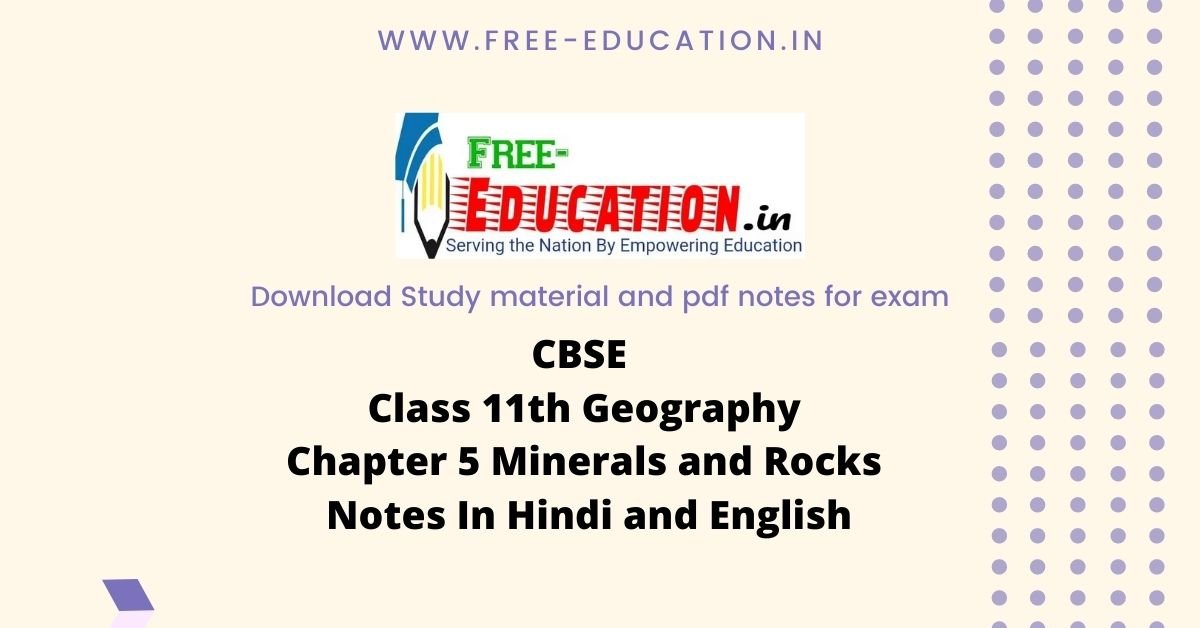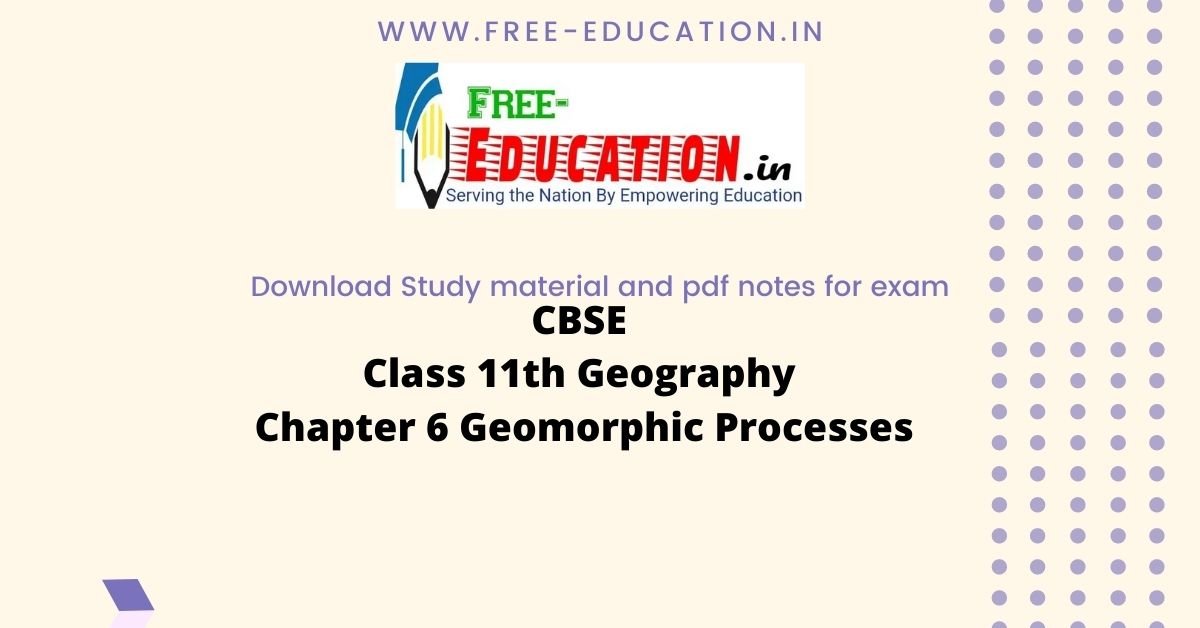Class 11 Geography NCERT Solutions Chapter 5 Minerals and Rocks
Class 11 Geography Chapter 5 NCERT Textbook Questions Solved
1. Multiple choice questions.
Question 1(i).
Which one of the following are the two main constituents of granite?
(a) Iron and nickel
(b) Iron and silver
(c) Silica and aluminium
(d) Iron Oxide and potassium
Answer:
(c) Silica and aluminium
Question 1(ii).
Which one of the following is the salient feature of metamorphic rocks?
(a) Changeable
(b) Quite
(c) Crystalline
(d) Foliation
Answer:
(a) Changeable
Question 1(iii).
Which one of the following is not a single element mineral?
(a) Gold
(b) Silver
(c) Mica
(d) Graphite
Answer:
(c) Mica
Question 1(iv).
Which one of the following is the hardest mineral?
(a) Topaz
() Diamond
(c) Quartz
(d) Feldspar
Answer:
(b) Diamond
Question 1(v).
Which one of the following is not a sedimentary rock?
(a) Tillite
(6) Borax
(c) Breccia
(d) Marble
Answer:
(d) Marble
2. Answer the following questions in about 30 words.
Question 2(i).
What do you mean by rocks? Name the three major classes of rocks.
Answer:
The earth’s crust is composed of rocks. A rock is made up by aggregate of one or more minerals. Rock may be hard or soft and in varied colors. For example, granite is hard, soapstone is soft. Gabbro is black and quartzite can be milky white. Rocks do not have a definite composition of mineral constituents. Feldspar and quartz are the most common minerals found in rocks.
There are many different kinds of rocks which are grouped under three families on the basis of their mode
of formation.
They are:
- Igneous Rocks
- Sedimentary Rocks and
- Metamorphic Rocks.
Question 2(ii).
What is an igneous rock? Describe the method of formation and characteristics of igneous rock.
Answer:
The igneous rocks are formed when magma cools and solidifies. Igneous rocks form out of magma and lava from the interior of the earth, therefore, they are known as primary rocks.
Method of formation: When magma in its upward movement cools and turns into solid form it is called igneous rock. The process of cooling and solidification can happen in the earth’s crust or on the surface of the earth. Igneous rocks are classified based on texture. The texture depends upon the size and arrangement of grains or other physical conditions of the materials. If molten material is cooled slowly at great depths, mineral grains may be very large. Sudden cooling (at the surface) results in small and smooth grains. Intermediate conditions of cooling would result in intermediate sizes of grains making up igneous rocks. Granite, gabbro, pegmatite, basalt, volcanic breccia and tuff are some of the examples of igneous rocks.
Features:
- They are made up of solidified lava.
- Liquid lava gets solidified by gradual cooling
- They are compact
- They do not have fossils.
Question 2(iii).
What is meant by sedimentary rock? Describe the mode of formation of sedimentary rock.
Answer:
The word ‘sedimentary’ is derived from the Latin word sedimentum, which means settling. All types of rocks of the earth’s surface are exposed to denudational agents, and are broken up into various sizes of fragments. Such fragments are transported by different exogenous agencies and deposited.
These deposits through compaction turn into rocks. This process is called lithification. In many sedimentary rocks, the layers of deposits retain their characteristics even after lithification. Hence, we see a number of layers of varying thickness in sedimentary rocks like sandstone, shale etc.
Question 2(iv).
What relationship explained by rock cycle between the major type of rocks?
Answer:
Rocks do not remain in their original form for long but may undergo transformation. Rock cycle is a continuous process through which old rocks are transformed into new ones. Igneous rocks are primary rocks and other rocks (sedimentary and metamorphic) form from these primary rocks. Igneous rocks can be changed into metamorphic rocks. The fragments derived out of igneous and metamorphic rocks form into sedimentary rocks.
Sedimentary rocks themselves can turn into fragments and the fragments can be a source for formation of sedimentary rocks. The crustal rocks (igneous, metamorphic and sedimentary) once formed may be carried down into the mantle (interior of the earth) through subduction process (parts or whole of crustal plates going down under another plate in zones of plate convergence) and the same melt down due to increase in temperature in the interior and turn into molten magma, the original source for igneous rocks.
3. Answer the following questions in about 150 words.
Question 3(i).
Define the term ‘mineral’ and name the major classes of minerals with their physical characteristics.
Answer:
A mineral is a naturally occurring organic and inorganic substance, having an orderly atomic structure and a definite chemical composition and physical properties. A mineral is composed of two or more elements. But, sometimes single element minerals like sulphur, copper, silver, gold, graphite etc. are found. There are at least 2,000 minerals that have been named and identified in the earth crust; but almost all the commonly occurring ones are related to six major mineral groups that are known as major rock forming minerals.
Some major minerals and their characteristics:
- Feldspar: Silicon and oxygen are common elements in all types of feldspar and sodium, potassium, calcium, aluminium etc. are found in specific feldspar variety.
- Quartz: It is one of the most important components of sand and granite. It consists of silica. It is a hard mineral virtually insoluble in water.
- Pyroxene: Pyroxene consists of calcium, aluminum, magnesium, iron and silica. Pyroxene forms 10 per cent of the earth’s crust.
- Amphibole: Aluminium, calcium, silica, iron, magnesium are the major elements of amphiboles. They form 7 percent of the earth’s crust.
- Mica: It comprises of potassium, aluminium, magnesium, iron, silica, etc. It forms 4 per cent of the earth’s crust.
- Olivine: Magnesium, iron and silica are major elements of olivine. It is used in jewellery. It is usually a greenish crystal, often found in basaltic rocks.
- Metallic Minerals: These minerals contain metal content and can be sub-divided into three types:
- Precious metals,
- Ferrous metals
- Non- ferrous metals.
Question 3(ii).
Describe the nature and mode of origin of the chief types of rock at the earth’s crust. How will you distinguish them?
Answer:
The earth’s crust is composed of rocks. A rock is made up by aggregate of one or more minerals. Rock may be hard or soft and in varied colours. For example, granite is hard, soapstone is soft. Gabbro is black and quartzite can be milky white. Rocks do not have definite composition of mineral constituents. Feldspar and quartz are the most common minerals found in rocks.
There are many different kinds of rocks which are grouped under three families on the basis of their mode of formation. They are:
- Igneous Rocks
- Sedimentary Rocks and
- Metamorphic Rocks.
1. Igneous Rocks: The igneous rocks are formed when magma cools and solidifies. Igneous rocks form out of magma and lava from the interior of the earth, therefore, they are known as primary rocks. When magma in its upward movement cools and turns into solid form it is called igneous rock. Intermediate conditions of cooling would result in intermediate sizes of grains making up igneous rocks. Granite, gabbro, pegmatite, basalt, volcanic breccia and tuff are some of the examples of igneous rocks.
2. Sedimentary Rocks: The word ‘sedimentary’ is derived from the Latin word sedimentum, which means ‘settling’. All types of rocks of the earth’s surface are exposed to denudational agents, and are broken up into various sizes of fragments. Such fragments are transported by different exogenous agencies and deposited. These deposits through compaction turn into rocks. This process is called lithification. In many sedimentary rocks, the layers of deposits retain their characteristics even after lithification. Hence, we see a number of layers of varying thickness . in sedimentary rocks like sandstone, shale, etc.
3. Metamorphic Rocks: The word ‘metamorphic’ means ‘change of form’. These rocks form under the action of pressure, volume and temperature (PVT) changes. Metamorphism occurs when rocks are forced down to lower levels by tectonic processes or when molten magma rising through the crust comes in contact with the crustal rocks or the underlying rocks are subjected to great amounts of pressure by overlying rocks.
Question 3(iii).
What are metamorphic rocks? Describe the types of metamorphic rock and how are they formed?
Answer:
The word metamorphic means ‘change of form’. These rocks form under the action of pressure, volume and temperature (PVT) changes. Metamorphism takes place when rocks are forced down to lower levels by tectonic processes or when molten magma rising through the crust comes in contact with the crustal rocks or the underlying rocks are subjected to great amounts of pressure by overlying rocks. Metamorphism is a process by which already consolidated rocks undergo recrystallisation and reorganisation of materials within original rocks.
Mechanical disruption and reorganisation of the original minerals within rocks because of breaking and crushing without any appreciable chemical changes is called dynamic metamorphism. The materials of rocks chemically alter and recrystallise due to thermal metamorphism.
There are two types of thermal metamorphism:
1. Contact metamorphism: In contact metamorphism the rocks come in contact with hot intruding magma and lava and the rock materials recrystallise under high temperatures. Quite often new materials form out of magma or lava are added to the rocks.
2. Regional metamorphism: In regional metamorphism, rocks undergo recrystallisation due to deformation caused by tectonic shearing together with high temperature or pressure or both.
During metamorphism in some rocks grains or minerals get arranged in layers or lines. Such an arrangement of minerals or grains in metamorphic rocks is called foliation or lineation. Sometimes minerals or materials of different groups are arranged into alternating thin to thick layers appearing in light and dark shades. Such a structure in metamorphic rocks is called banding and rocks displaying banding are called banded rocks. Types of metamorphic rocks depend upon original rocks that were subjected to metamorphism. Metamorphic rocks are classified into two major groups foliated rocks and non-foliated rocks. Gneissoid, granite, syenite, slate, schist, marble, quartzite etc. are some examples of metamorphic rocks.
Project Work
1. Collect different rock samples and try to recognise them from their physical characteristics and identify their family.
Answer:
Do it yourself.
Class 11 Geography Chapter 5 NCERT Extra Questions
Class 11 Geography Chapter 5 Multiple Choice Questions
Question 1.
Science of minerals is called:
(a) Mineralogy
(b) Mineral Science
(c) Petrology
(d) Ironology.
Answer:
(c) Petrology
Question 2.
Which rocks are formed by metamorphism of lime stone?
(a) Marble
(b) Slate
(c) Granite
(d) Schist.
Answer:
(a) Marble
Question 3.
Petrology does not study:
(a) Structure of Minerals
(b) Shape and Organization of Minerals
(c) Sources of Minerals
(d) Types of rocks.
Answer:
(d) Types of rocks.
Question 4.
Which of the following is not an example of metamorphic rocks?
(a) Slate
(b) Marble
(c) Limestone
(d) Schist.
Answer:
(c) Limestone
Question 5.
During metamorphism in some rocks grains or minerals get arranged in layers or lines. Such an arrangement of minerals or grains in metamorphic rocks is called what?
(a) Lineation
(b) Arrangement
(c) Functionality
(d) Disshaping.
Answer:
(a) Lineation
Question 6.
Which of the following mineral is hardest?
(a) Gypsum
(b) Calcite
(c) Topaz
(d) Diamond.
Answer:
(d) Diamond
Question 7.
Which of the following mineral is non metallic?
(a) Iron
(b) Copper
(c) Coal
(d) Gold.
Answer:
(c) Coal
Question 8.
Which of the following is not a sedimentary rock?
(a) Sandstone
(b) Coal
(c) Limestone
(d) Marble.
Answer:
(d) Marble.
Question 9.
Which of the following is not an example of igneous rocks?
(a) Granite
(b) Gabbro
(c) Pegmatite
(d) Marble.
Answer:
(d) Marble.
Question 10.
98% of the crust of the earth is made of eight elements. Which of the following is not among these eight elements?
(a) Oxygen and Silicon
(b) Aluminium and Iron
(c) Calcium and Sodium
(d) Mica and Granite.
Answer:
(d) Mica and Granite.
Question 11.
Which of the following is not a precious metal?
(a) Gold
(b) Silver
(c) Platinum
(d) Copper.
Answer:
(d) Copper.
Question 12.
Which of the following is a ferrous mineral?
(a) Copper
(b) Iron Ore
(c) Aluminium
(d) Tin.
Answer:
(b) Iron Ore
Question 13.
Which of the following is a non-ferrous mineral?
(a) Copper
(b) Aluminium
(c) Tin
(d) All of the above.
Answer:
(d) All of the above.
Class 11 Geography Chapter 5 Very Short Answer Type Questions
Question 1.
What does Pyroxene consists of? What percent of the earth does it occupy? What kind of colour it has?
Answer:
Pyroxene consists of calcium, aluminum, magnesium, iron and silica. Pyroxene forms 10 per cent of the earth’s crust. It is in green or black colour.
Question 2.
What does Amphibole consists of? What percent of the earth does it occupy? What kind of colour it has? Where is it used?
Answer:
Aluminium, calcium, silica, iron, magnesium are the major elements of amphiboles. They form 7 per cent of the earth’s crust. It is in green or black colour and is used in asbestos industry.
Question 3.
What are the important elements of the crust of the earth?
Answer:
About 98 percent of the total crust of the earth is composed of eight elements like oxygen, silicon, aluminium, iron, calcium, sodium, potassium and magnesium, and the rest is constituted by titanium, hydrogen, phosphorous, manganese, sulphur, carbon, nickel and other elements.
Question 4.
What do you mean by cleavage?
Answer:
The tendency to break in given directions producing relatively plane surfaces is called cleavage.
Question 5.
What do you mean by fracture?
Answer:
Internal molecular arrangement is sc complex that there are no planes o molecules; the crystal will break in an irregular manner, not along planes of cleavage.
Question 6.
What does Feldspar consists of? What percent of the earth does it occupy? What kind of colour it has? Where is it used?
Answer:
Silicon and oxygen are common elements in all types of feldspar and sodium, potassium, calcium, aluminium etc. are found in specific feldspar variety. Half of the earth’s crust is composed of feldspar. It has light cream to salmon pink colour. It is used in ceramics and glass making.
Question 7.
What is petrology?
Answer:
It is science of rocks. A petrologist studies rocks in all their aspects viz., mineral composition, texture, structure, origin, occurrence, alteration and relationship with other rocks.
Question 8.
Give some examples of igneous rocks.
Answer:
Granite, gabbro, pegmatite, basalt, volcanic breccia and tuff are some of the examples of igneous rocks.
Question 9.
What is rock cycle?
Answer:
Rock cycle is a continuous process through which old rocks are transformed into new ones.
Question 10.
What is Quartz? Give some of its features.
Answer:
It is one of the most important components of sand and granite. It consists of silica. It is a hard mineral virtually insoluble in water. It is white or colourless and used in radio and radar. It is one of the most important components of granite.
Question 11.
What is the form of inner and outer form of the earth?
Answer:
The interior most part of the earth is in liquid form but its uppermost layer is in the form of solid.
Question 12.
What is the root source of all types of rocks?
Answer:
Magma which is found in the interior of the earth is the root source of all minerals.
Question 13.
Give one example of solid, liquid and gaseous form of minerals.
Answer:
Solid form of minerals is coal, liquid form is petroleum and diesel and gaseous form is natural gas.
Question 14.
What does mica consists of? What per cent, of the earth crust consists of mica? In which type of rocks is it found? Where is it used?
Answer:
It comprises of potassium, aluminium, magnesium, iron, silica etc. It forms 4 per cent of the earth’s crust. It is commonly found in igneous and metamorphic rocks. It is used in electrical instruments.
Question 15.
What are non-metallic minerals? Give examples.
Answer:
These minerals do not contain metal content. Sulphur, phosphates and nitrates are examples of non-metallic minerals. Cement is a mixture of non- metallic minerals.
Question 16.
What does Olivine consists of? In which type of rocks is it found?
Answer:
Magnesium, iron and silica are major elements of olivine. It is used in jewellery. It is usually a greenish crystal, often found in basaltic rocks.
Question 17.
What are the root sources of igneous rocks?
Answer:
Magma is the root source of igneous rocks. The igneous rocks are formed when magma cools and solidifies. When magma in its upward movement cools and turns into solid form it is called igneous rock. The process of cooling and solidification can happen in the earth’s crust or on the surface of the earth.
Question 18.
How does systematic formation of minerals take place?
Answer:
The basic source of all minerals is the hot magma in the interior of the earth. When magma cools, crystals of minerals appear and a systematic series of minerals are formed in sequence to solidify so as to form rocks.
Question 19.
What kind of qualities do minerals have?
Answer:
A mineral is a naturally occurring organic and inorganic substance having an orderly atomic structure and a definite chemical composition and physical properties for example sulphur, copper, silver, and gold, etc.
Question 20.
Name the minerals which are single elements?
Answer:
Sulphur, copper, silver, gold, graphite are single elements.
Question 21.
Name the hardest and softest mineral?
Answer:
Diamond is the hardest and Talc is the softest mineral
Question 22.
Name the mineral which is used in Asbestos industry?
Answer:
Amphiboles is used in Asbestos industry.
Class 11 Geography Chapter 5 Short Answer Type Questions
Question 1.
Classify the sedimentary rocks on the basis of mode of formation.
Answer:
Depending upon the mode of formation, sedimentary rocks are classified into three major groups:
- Mechanically formed: Some of its examples are sandstone, conglomerate, limestone, shale, loess, etc.
- Organically formed: Some of its examples are geyserite, chalk, limestone, coal, etc.
- Chemically formed: Some of its examples are chert, limestone, halite, potash, etc.
Question 2.
What are metallic minerals? Explain their classification with examples.
Answer:
These minerals contain metal content and can be sub-divided into three types:
- Precious metals: Gold, silver, platinum, etc.
- Ferrous metals: Iron, nickel, chromite, maganese.
- Non-ferrous metals: Copper, lead, zinc, tin, etc.
Question 3.
Explain the features of sedimentary rocks.
Answer:
The word ‘sedimentary’ is derived from the Latin word sedimentum, which means settling. All types of rocks of the earth’s surface are exposed to denudational agents, and are broken up into various sizes of fragments. Such fragments are transported by different exogenous agencies and deposited. These deposits through compaction turn into rocks. This process is called lithification. In many sedimentary rocks, the layers of deposits retain their characteristics even after lithification. Hence, we see a number of layers of varying thickness in sedimentary rocks like sandstone, shale, etc.
Question 4.
Differentiate between:
- Minerals and rocks
- Sedimentary and igneous rocks
- Igneous and metamorphic rocks
- Extrusive Igneous and intrusive igneous.
Answer:
(i) Minerals and rocks
| S.no | Minerals | Rocks |
| 1. | Naturally occurring substances with the definite chemical and physical composition. | Solid or the soften portion of the earth crust. |
| 2. | May be composed of two or more elements. | Are of three types and comprises of various metals. |
| 3. | More than 2, 000 minerals exist. | Classified as Igneous, sedimentary and Metamorphic rocks. |
(ii) Sedimentary and igneous rocks
| S.no | Sedimentary rocks | Igneous rocks |
| 1. | Made up of sediments. | Made up of solidified lava. |
| 2. | Loose sediments get sedimented into rocks. | Liquid lava gets solidified by gradual cooling. |
| 3. | Form in layers. | They are compact. |
| 4. | Contains fossils. | Do not have fossils. |
| 5. | Are organic and inorganic in nature. | They are extrusive or intrusive. |
| 6. | Permeable and allow water to seep. | In permeable and do not allow water to seep. |
| 7. | They are known as secondary rocks, these are of two types: Intrusive- granite, Diorite; Extrusive-basalt. | They are known as primary rocks e.g. organic rock-coal, limestone Inorganic- sandstone, shale. |
(iii) Igneous and metamorphic rocks
| S.no | Igneous rocks | Metamorphie rocks |
| 1. | Magma cools and solidifies. | Igneous and sedimentary rocks and are changed into metamorphie rock due to heat and temperature. |
| 2. | Igneous rocks are normally crystalline and are of two types- Intrusive and Extrusive. | Metamorphism can be of two types contact metamorphism and regional metamorphism. |
| 3. | Hard, Impermeable in nature. | They are also hard but have formed due to change in igneous and sedimentary rocks for e.g. Limestone changes into marble, sandstone into quartzite and coal into graphite. |
| 4. | In igneous rocks no bands are seen. | In metamorphie rocks banding is a normal. |
| 5. | In the intensive igneous rocks the cooling and solidification decides the size of the particles. | The arrangement of the minerals of granules is called lineation. |
(iv) Extrusive Igneous and intrusive igneous.
| S.no | Extrusive Igneous | Intrusive Igneous |
| 1. | Lava cools rapidly on the surface of earth. | Cooling and solidification occurs inside the earth surface and is a slow process. |
| 2. | Minerals crystals of extrusive igneous rocks change their structure and can became very small in size e.g. Basalt. | They are the coarse granule structure e.g. Granite Doloride. |
Class 11 Geography Chapter 5 Long Answer Type Questions
Question 1.
Explain any six physical characteristics?
Answer:
Brief information about some important minerals in terms of their nature and physical characteristics is given below :
- External crystal form: Determined by internal arrangement of the molecules- cubes octahedrons, hexagonal prism, etc.
- Fracture: Internal molecular arrangement so complex there are two planes of molecules; the crystal will break in an irregular manner, not along planes of cleavage.
- Lustre: Appearance of a material without regard to color; each mineral has a distinctive lustre like metallic, silky, glossy, etc.
- Streak: Colour of the ground powder of any mineral. It may be of the same colour as the mineral or may differ malachite is green and gives green streak.
- Structure: Particular arrangement of the individual crystal; fine, medium or coarse grained; fibrous separable, divergent and radiating.
- Specific gravity: The ratio between the weight of a given object and the weight of an equal volume of water; object weighted in air and then weighed in water and divide weight in air by the difference of the two weights.
Question 2.
Explain some important minerals and their characteristics.
Answer:
Some major minerals and their characteristics
- Feldspar: Silicon and oxygen are common elements in all types of feldspar and sodium, potassium, calcium, aluminium etc. are found in specific feldspar variety.
- Question uartz: It is one of the most important components of sand and granite. It consists of silica. It is a hard mineral virtually insoluble in water.
- Pyroxene: Pyroxene consists of cak ium, aluminum, magnesium, iron and silica. Pyroxene forms 10 percent of the earth’s crust.
- Amphibole: Aluminium, calcium, silica, iron, magnesium are the major elements of amphiboles. They form 7 per cent of the earth’s crust.
- Mica: It comprises of potassium, aluminium, magnesium, iron, silica etc. It forms 4 per cent of the earth’s crust.
- Olivine: Magnesium, iron and silica are major elements of olivine. It is used in jewellery. It is usually a greenish crystal, often found in basaltic rocks.
Question 3.
Rocks do not remain in their original form for long but may undergo transformation. Explain.
Answer:
Rocks do not remain in their original form for long but may undergo transformation. Rock cycle is a continuous process through which old rocks are transformed into new ones. Igneous rocks are primary rocks and other rocks form from these primary rocks. Igneous rocks can be changed into metamorphic rocks. The fragments derived out of igneous and metamorphic rocks form into sedimentary rocks. Sedimentary rocks themselves can turn into fragments and the fragments can be a source for formation of sedimentary rocks. The crustal rocks (igneous, metamorphic and sedimentary) once formed may be carried down into the mantle through subduction process and the same melt down due to increase in temperature in the interior and turn into molten magma, the original source for igneous rocks

Class 11 Geography Chapter 3 HOTS Questions
Question 1.
Igneous rocks act as a source of all other types of rocks. Justify.
Answer:
Yes, it is right to say that igneous rocks act as a source of all other rocks. Therefore these are also called primary rocks.
Igneous rocks are primary rocks and other rocks i.e. sedimentary and metamorphic formed from these primary rocks. Igneous rocks can be changed into metamorphic rocks. The fragments derived out of igneous and metamorphic rocks form into sedimentary rocks. Sedimentary rocks themselves can turn into fragments and the fragments can be a source for formation of sedimentary rocks. The crustal rocks (igneous, metamorphic and sedimentary) once formed may be carried down into the mantle (interior of the earth) through subduction process (parts or whole of crustal plates going down under another plate in zones of plate convergence) and the same melt down due to increase in temperature in the interior and turn into molten magma, the original source for igneous rocks.
Question 2.
Metallic minerals are more useful as compared to non metallic minerals. Do you agree? Justify your answer.
Answer:
No, I do not agree. Minerals both metallic and non metallic have their own importance.
1. Metallic minerals: These minerals contain metal content and can be sub-divided into three types:
- Precious metals: Gold, Sivler, Platinum, etc
- Ferrous metals: Iron, Nickel, Chromite, Maganese
- Non-ferrous metals: Copper, Lead, Zinc, Tin etc.
2. Non metallic minerals: These minerals do not have a metal content. Sulphur, phosphates and nitrates are some of the examples. Cement is a mixture of non metallic mineral. These minerals have their own utility. We can’t manage without these minerals.
Related link you must like:-
Study material for Competition Exam
Mohd. Sharif Qualification: B.Tech (Mechanical Engineering) [Founder of Wisdom Academy] [Aim Foundation & Free-Education.In] [Engineer By Profession | Teacher By Choice] [Blogger, YouTube Creator]






